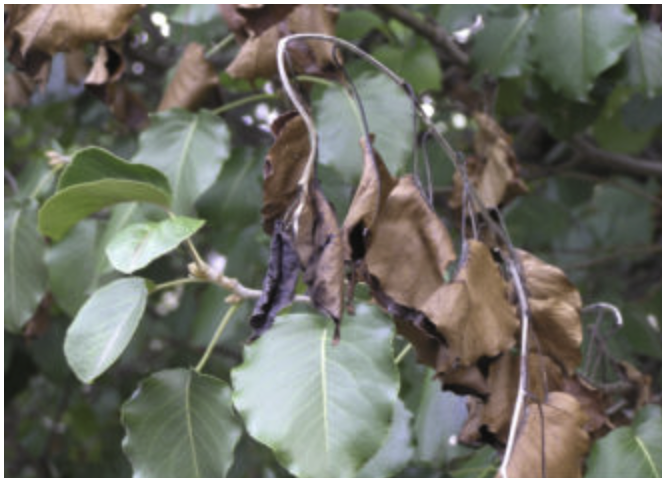Fire Blight Showing Up on Apple and Pear Trees
go.ncsu.edu/readext?1004715
en Español / em Português
El inglés es el idioma de control de esta página. En la medida en que haya algún conflicto entre la traducción al inglés y la traducción, el inglés prevalece.
Al hacer clic en el enlace de traducción se activa un servicio de traducción gratuito para convertir la página al español. Al igual que con cualquier traducción por Internet, la conversión no es sensible al contexto y puede que no traduzca el texto en su significado original. NC State Extension no garantiza la exactitud del texto traducido. Por favor, tenga en cuenta que algunas aplicaciones y/o servicios pueden no funcionar como se espera cuando se traducen.
Português
Inglês é o idioma de controle desta página. Na medida que haja algum conflito entre o texto original em Inglês e a tradução, o Inglês prevalece.
Ao clicar no link de tradução, um serviço gratuito de tradução será ativado para converter a página para o Português. Como em qualquer tradução pela internet, a conversão não é sensivel ao contexto e pode não ocorrer a tradução para o significado orginal. O serviço de Extensão da Carolina do Norte (NC State Extension) não garante a exatidão do texto traduzido. Por favor, observe que algumas funções ou serviços podem não funcionar como esperado após a tradução.
English
English is the controlling language of this page. To the extent there is any conflict between the English text and the translation, English controls.
Clicking on the translation link activates a free translation service to convert the page to Spanish. As with any Internet translation, the conversion is not context-sensitive and may not translate the text to its original meaning. NC State Extension does not guarantee the accuracy of the translated text. Please note that some applications and/or services may not function as expected when translated.
Collapse ▲Fire blight is one of the most devastating and difficult-to-control diseases of many fruit trees, including apple and pear, as well as of other ornamental plants in the rose family (much more than typical garden roses) which includes trees and shrubs in orchards, nurseries, and landscape plantings.
 This is a bacterial disease caused by Erwinia amylovora, that is destructive, highly infectious, and can spread rapidly, killing individual apple and pear trees when conditions are right for disease development and if susceptible rootstocks are used. Initially, the disease often enters the tree through natural openings, especially flowers and wounds in the spring. It can be spread from diseased to healthy plants by rain, wind, and pruning tools. It can kill or disfigure a tree or shrub, depending on the susceptibility of the host and weather conditions. Procrastination is not your friend in this case.
This is a bacterial disease caused by Erwinia amylovora, that is destructive, highly infectious, and can spread rapidly, killing individual apple and pear trees when conditions are right for disease development and if susceptible rootstocks are used. Initially, the disease often enters the tree through natural openings, especially flowers and wounds in the spring. It can be spread from diseased to healthy plants by rain, wind, and pruning tools. It can kill or disfigure a tree or shrub, depending on the susceptibility of the host and weather conditions. Procrastination is not your friend in this case.
The first symptoms of fire blight occur in early spring when temperatures are above 60 °F and the weather is rainy or humid. How can you recognize this problem? The first symptoms usually start with the blossom appearing water soaked then drooping and browning, blackening then they dieback. The disease continues growing down through the twig, killing as it moves systemically. Cankers form at the base of the dead areas on the woody plant tissue. Bacterial ooze may leak from cracks along canker margins or through pores in the bark called lenticels. This bacterial ooze can attract bees and other insects who then help spread the disease to healthy plants. The bacteria spread rapidly through the plant tissue in warm temperatures (65°F or higher) and humid weather.The highly invasive callery pear, which is often seen along the margins of fields, is very susceptible to fire blight and can be a source of the disease.
Preventive spraying in early spring with streptomycin or copper-based fungicides is possible in a commercial orchard setting. However, for most homeowners the cost and effort is not reasonable. Trees need to be sprayed at a 3-to-4-day interval during bloom and the entire leaf canopy must be treated with good coverage for control.
On pear, the killed twigs/branches are black-looking while the killed tissue on other rose family plants will be brown to chocolate brown in color. Often, but not always, the tip of the twig/branch curls back on itself thus forming a “shepherds crook” appearance.
While there is no cure, if this disease has found its way into your landscape you can reduce the opportunities of it spreading by removing and destroying all affected parts of the tree or shrub after the danger of disease development is over. Don’t wait to deal with pruning out the infection, the disease won’t – BUT “don’t wound when it’s wet”. On a warm, dry day during spring and summer, prune out infected branches 8 -12 inches below the damage. I know – that’s a lot but better safe than sorry. Dip pruning tools in 70% rubbing alcohol or 10 % bleach solution (1 part bleach to 9 parts water solution) between each cut. Wash and oil shears when you are finished. These practices avoid spreading the pathogen.
Avoid heavy nitrogen fertilization, especially in summer, when succulent growth is most susceptible to fire blight infection.
To read more about this disease, contact me at minda_daughtyry@ncsu.edu or learn more about Fire Blight on Fruit Trees at Clemson.edu.




